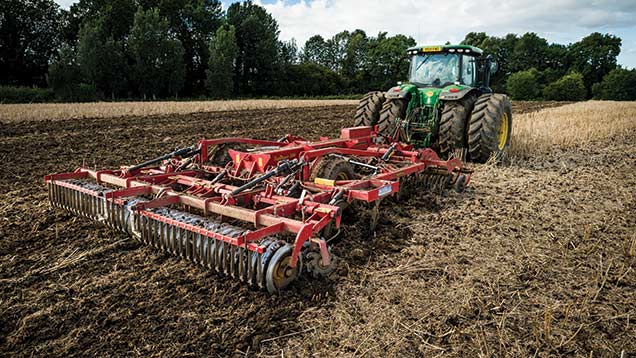Tillage-Live 2015: Show’s host farm reveals its min-till secrets
 © Jim Varney
© Jim Varney Diverse cropping, including spring-sown crops and routine use of ploughing – cultural options that growers using min-till across the board are being urged to adopt to combat blackgrass – have helped Croft Farms introduce min-till without the issues experienced by some growers.
See also: Tillage Live 2014 moves to Gloucestershire
Anthony Hornshaw, recently retired manager of the 1,400ha in-house and contract farming operation at Croft-on-Tees near Darlington anticipated as much when describing the change of approach ahead of the Tillage event in 2005.
“I’m aware that the grassweed situation must be watched and nipped in the bud if they do begin to make their presence felt,” he said at the time.
Farm facts: Croft Farms
- Farming 1,400ha in-hand and on contract
- Winter wheat – first 600ha
- Oilseed rape – 300ha
- Winter barley – 100ha
- Spring beans – 100ha
- Christmas trees – 24ha
- Winter oats – 100ha
“A cropping rotation that keeps the plough working around the farm should help keep this potential headache at bay.”
And that has proved to be the case, according to manager Matt Bell, who took over the reins last December.
“We have some concentrated and well-defined problem areas but there’s no widespread grassweed problem,” he confirms.
“The diverse rotation and different cultivation practices have certainly worked in that respect, but we remain vigilant. All farm staff report on the presence of blackgrass, while spreading or spraying and immediate action is taken such as hand-roguing or spot-spraying with glyphosate.”
For the most part, the crop establishment methods adopted 10 years ago have continued unchanged on mostly Dunkeswell medium clay loam soils that Matt Bell warns Tillage-Live exhibitors can be challenging after rain as well as when very dry.
Generous plots
“The generous Tillage-Live plots on bare stubble alongside the Croft airfield will provide decent enough working conditions to show off what the equipment can do,” he says.
“And although we’re not looking to make any changes to our own system at present, it will be a brilliant opportunity to see different types of equipment working our soils all on the same day.”
Fields destined for first wheats having grown break crops are cultivated now as 10 years ago by a Vaderstad TopDown disc and tine cultivator, albeit using a 5m implement rather than a 4m version.
“It would be complacent to think what we’re doing here is perfect but the reality is we’re quite happy with the way things are going”
Matt Bell, Croft Farms
A veteran Simba Cultipress follows to further work up a consolidated tilth ready for final preparation by the seed drill’s cultivating discs.
The Cultipress – still going strong with a new set of rings installed behind the rigid tines – also works down land ploughed for second wheats, winter barley and winter oats.
But it is not usually needed after ploughing for spring crops – mainly spring beans –which are also sown by the farm’s Vaderstad Rapid System Disc drill.
The Rapid bought for the switch to min-tillage has been another enduring implement – it was replaced by another 6m example last year having got some 8.900ha of work under its belt.
Seven-leg subsoiler
Establishing oilseed rape is one operation that has changed in the intervening years; instead of being sown by the Vaderstad drill, crops are “sub-till” sown using a He-Va seven-leg subsoiler from Opico with a fertiliser dispensing kit.
“This approach provides the soil loosening at depth that benefits the deep-rooting characteristics of oilseed rape and the low cost, high output of a one-pass system,” notes Matt Bell.
“We use the TopDown to create a tilth one to two inches deep if the winter barley stubbles are especially hard, to get a fortnight’s weathering effect and a chit, but otherwise the subsoiler sowing technique is pretty flexible in terms of weather and soil conditions.”
Oilseed rape is certain to retain its place in the Croft Farms rotation with a similar acreage as last year, in part thanks to the lack of flea beetle problems that many growers further south experience.
“Flea beetle is not a problem here; oilseed rape has been sown for years without any insecticide treatment,” says Matt Bell.
“Together with mainly one-pass cultivation and seeding, that makes the crop cheapish to grow and we’ve harvested some excellent yields this year.”
With no appreciable grassweed problems nor flea beetle issues, it sounds as though the new manager has landed a good berth.
“It would be complacent to think what we’re doing here is perfect but the reality is we’re quite happy with the way things are going,” he says.



